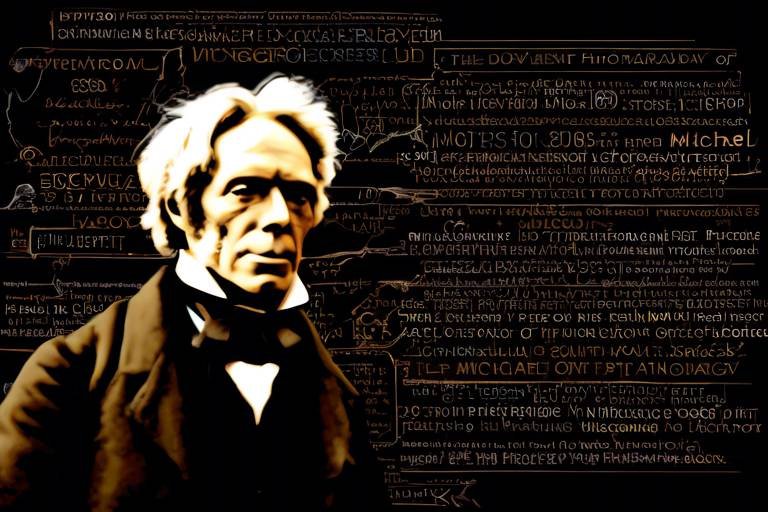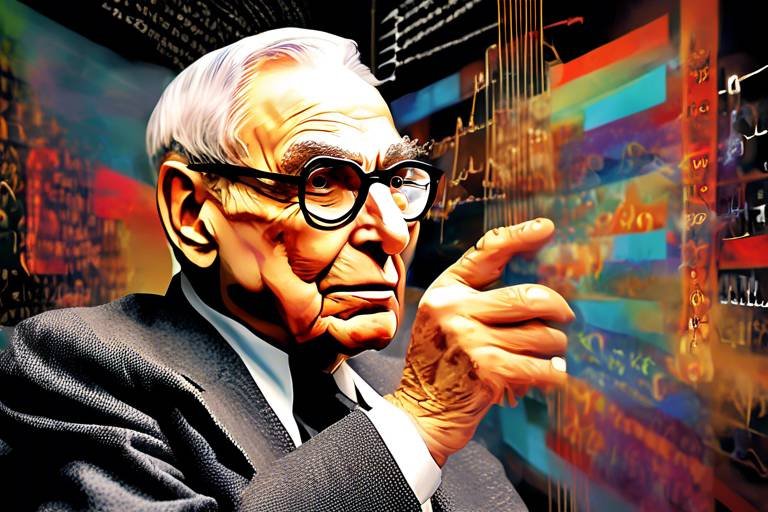The Work of James Clerk Maxwell in Electromagnetism
James Clerk Maxwell, a name that resonates through the corridors of physics, is often regarded as one of the most significant figures in the field of electromagnetism. His groundbreaking work not only transformed our understanding of electric and magnetic fields but also laid the foundation for many modern technologies we rely on today. Imagine a world without radio waves or wireless communication; it's hard to fathom, right? Maxwell's genius was in his ability to connect the dots between various phenomena, leading to the formulation of what we now know as Maxwell's Equations. These equations are not just mathematical expressions; they are the heartbeat of electromagnetic theory, describing how electric charges and currents generate electric and magnetic fields. In this article, we will delve into the remarkable contributions of Maxwell, exploring his theories, equations, and the profound impact they have had on both physics and technology.
Maxwell's equations are a set of four fundamental equations that describe how electric and magnetic fields interact. They encapsulate the relationship between charges, currents, and the fields they produce, revolutionizing our understanding of electromagnetic phenomena. To put it simply, these equations are like the rules of a game that govern how electricity and magnetism play together in the universe. Without them, our comprehension of light, radio waves, and even the very fabric of space would be fundamentally flawed. The equations can be summarized as follows:
| Equation | Description |
|---|---|
| Gauss's Law | Relates electric fields to the distribution of charge. |
| Gauss's Law for Magnetism | States that there are no magnetic monopoles; magnetic field lines are closed loops. |
| Faraday's Law of Induction | Describes how a changing magnetic field can induce an electric field. |
| Ampère-Maxwell Law | Links magnetic fields to the currents and electric fields that produce them. |
Maxwell's genius did not emerge in a vacuum; he built upon the foundational work of earlier scientists, integrating their discoveries into a cohesive theoretical framework. Think of him as a master chef, taking various ingredients from the scientific pantry and creating a deliciously complex dish. His ability to synthesize existing knowledge laid the groundwork for modern electromagnetic theory and advanced scientific inquiry. By marrying the concepts of electricity and magnetism, Maxwell not only illuminated the path for future researchers but also sparked a revolution in how we perceive the physical world.
Electrostatics, the study of stationary electric charges, is a crucial component of Maxwell's work. His insights into electric fields and potentials were like opening a door to a new dimension of understanding. For instance, the concept of electric field lines, which Maxwell introduced, allows us to visualize how electric fields behave and interact with charged objects. This visualization is not just academic; it has practical applications in electrical engineering and physics. Imagine trying to navigate a complex maze without a map; that's what understanding electric fields would be like without Maxwell's contributions.
One of the cornerstones of Maxwell's equations is Gauss's Law, which relates electric fields to the distribution of charge. This principle is essential for understanding how charges interact. It’s like having a magnifying glass that allows you to see the invisible forces at play in the universe. This law has practical applications in various technologies, from designing capacitors to understanding how electric fields behave in different materials.
Maxwell's introduction of electric field lines was revolutionary. By visualizing electric fields, we can better understand their behavior and interactions with charged objects. These lines not only help in comprehending theoretical concepts but also have practical implications in designing electrical circuits and devices. It's like having a roadmap for navigating the complexities of electromagnetism.
Magnetostatics focuses on magnetic fields produced by steady currents. Maxwell's contributions in this area were pivotal in clarifying the relationship between electricity and magnetism. He demonstrated that these two forces are not isolated but are interdependent, leading to the unification of these fundamental forces. This realization was akin to discovering that two seemingly different worlds were, in fact, part of the same grand tapestry of physics.
One of Maxwell's most groundbreaking predictions was the existence of electromagnetic waves. He showed that electric and magnetic fields could propagate through space, much like ripples on a pond. This discovery laid the foundation for technologies such as radio, television, and wireless communication. Imagine a world where information could not travel without wires; Maxwell's work changed that narrative forever.
The wave equation derived from Maxwell's equations describes how electromagnetic waves travel through different media. Understanding this equation is crucial for the development of various communication technologies. It's like having the blueprint for constructing a bridge that connects two distant lands, enabling the flow of information across vast distances.
Maxwell's work significantly influenced modern physics, inspiring future scientists such as Einstein. His contributions laid the groundwork for the development of quantum mechanics and relativity. Maxwell's legacy continues to shape our understanding of the universe, reminding us that the quest for knowledge is an ever-evolving journey. His work is a testament to the power of curiosity and the importance of building upon the ideas of those who came before us.
- What are Maxwell's equations? Maxwell's equations are a set of four fundamental equations that describe how electric and magnetic fields interact.
- Why are Maxwell's contributions important? His work laid the foundation for modern electromagnetic theory, influencing technologies like radio and wireless communication.
- How did Maxwell's work impact modern physics? Maxwell's theories inspired future scientists and contributed to the development of quantum mechanics and relativity.

Maxwell's Equations
Maxwell's equations are nothing short of a revolution in the realm of physics. They form the bedrock of classical electromagnetism, elegantly encapsulating the intricate relationship between electric and magnetic fields. Imagine trying to navigate a vast ocean without a map; that’s how chaotic the understanding of electromagnetism was before Maxwell came along. His equations not only clarified the interactions between charged particles but also unified previously separate concepts into a cohesive framework that changed the scientific landscape forever.
At its core, Maxwell's equations describe how electric charges and currents create electric and magnetic fields. This was a monumental shift in thinking. Before Maxwell, electricity and magnetism were viewed as distinct phenomena. But Maxwell demonstrated that they are interconnected, like two sides of the same coin. His equations can be summarized as follows:
| Equation | Description |
|---|---|
| Gauss's Law | Describes the relationship between electric charge and electric field. |
| Gauss's Law for Magnetism | States that there are no magnetic monopoles; magnetic field lines are closed loops. |
| Faraday's Law of Induction | Indicates that a changing magnetic field creates an electric field. |
| Amperes-Maxwell Law | Shows that electric current and changing electric fields produce magnetic fields. |
These equations are not just theoretical constructs; they have practical implications that permeate our daily lives. Think about how we harness electricity to power our homes, the way we communicate wirelessly, or even how we navigate using GPS. All of these applications are rooted in the principles laid out by Maxwell.
One of the most astonishing aspects of Maxwell's equations is their ability to predict the existence of electromagnetic waves. This was akin to discovering a hidden treasure map that would lead to the development of technologies such as radio, television, and even the internet. By demonstrating that electric and magnetic fields can propagate through space, Maxwell opened the door to a new era of communication and connectivity.
Moreover, Maxwell's equations are not just limited to classical physics; they have had a profound impact on modern physics as well. They serve as a foundation for the development of quantum mechanics and have influenced great minds such as Albert Einstein. In essence, Maxwell's work is a testament to the power of human curiosity and the relentless pursuit of knowledge.
In summary, Maxwell's equations are a brilliant synthesis of earlier scientific discoveries, woven together into a framework that has stood the test of time. They are not merely equations; they are a gateway to understanding the very fabric of our universe.

Theoretical Foundations
James Clerk Maxwell was not just a lone genius working in a vacuum; he was the product of a rich tapestry of scientific inquiry that preceded him. His work is a stunning example of how collaboration and synthesis of ideas can lead to groundbreaking discoveries. Maxwell built upon the foundational theories established by earlier luminaries such as Michael Faraday and Anders Jonas Ångström, integrating their insights into a cohesive framework that would eventually redefine our understanding of electromagnetism. It's like taking the best pieces of a jigsaw puzzle and fitting them together to reveal a magnificent picture of how electricity and magnetism interrelate.
One of the most remarkable aspects of Maxwell's work is his ability to translate complex physical phenomena into mathematical language. He didn't just observe; he formulated laws that encapsulated the behavior of electric and magnetic fields. This mathematical formulation allowed scientists to predict outcomes in a way that was previously unimaginable. For example, his set of equations—now famously known as Maxwell's Equations—serves as the cornerstone of classical electromagnetism and has paved the way for numerous technological advancements.
Maxwell's genius lay in his ability to see beyond the individual contributions of his predecessors. He recognized the interconnectedness of various scientific principles and sought to unify them under a single theoretical umbrella. This approach was revolutionary. He took the disparate ideas surrounding electric and magnetic fields and showed how they were not just separate entities but rather two sides of the same coin. This unification is akin to discovering that the seemingly different colors of light are all part of a single spectrum.
To better understand Maxwell's theoretical foundations, consider the following key components:
- Electrostatics: The study of stationary electric charges, which Maxwell expanded upon to explain electric fields and potentials.
- Magnetostatics: The examination of magnetic fields produced by steady currents, which helped clarify the relationship between electricity and magnetism.
- Electromagnetic Induction: Maxwell's work on how changing electric fields can induce magnetic fields, further solidifying the connection between the two forces.
These elements not only advanced scientific inquiry but also laid the groundwork for practical applications that we rely on today. For instance, Maxwell's insights into electrostatics directly influenced the development of electrical engineering, enabling the creation of technologies that power our homes and industries. His work has been described as a catalyst for innovation, inspiring countless scientists and engineers to explore the implications of his theories.
In essence, Maxwell's theoretical foundations were not just a series of equations and principles; they represented a paradigm shift in how we perceive the natural world. His ability to synthesize existing knowledge and formulate comprehensive theories has left an indelible mark on physics, making him one of the most influential scientists in history.

Electrostatics
When we dive into the world of , we're exploring the fascinating realm of stationary electric charges. This field is not just a theoretical concept; it has real-world implications that shape our daily lives. Imagine the simple act of rubbing a balloon on your hair and watching it stick to the wall. This is electrostatics in action! Maxwell's insights into electric fields and potentials have paved the way for groundbreaking advancements in both electrical engineering and physics. His work fundamentally changed how we understand the forces at play in our universe.
One of the key components of electrostatics is the concept of the electric field. An electric field is a region around a charged object where other charges experience a force. Maxwell's formulations allow us to visualize these fields, making it easier to grasp how charges interact. To illustrate this, consider the following analogy: think of electric fields as invisible lines of force extending from a charged object, much like the rays of sunlight radiating from the sun. Just as sunlight can illuminate an entire room, electric fields can influence other charged particles within their reach.
One of the cornerstones of electrostatics is Gauss's Law, which relates electric fields to the distribution of charge. This principle is crucial for understanding how electric charges interact with one another. Essentially, Gauss's Law states that the electric flux through a closed surface is proportional to the charge enclosed within that surface. This relationship helps scientists and engineers calculate electric fields in complex geometries and is vital for designing various technologies, including capacitors and sensors.
Another important concept introduced by Maxwell is the visualization of electric fields through electric field lines. These lines provide a powerful tool for understanding the behavior of electric fields and their interactions with charged objects. By drawing electric field lines, we can easily see how the strength and direction of the field change in response to different charge distributions. For example, if we have a positive charge, the electric field lines radiate outward, indicating that other positive charges would repel each other, while negative charges would be attracted. This simple visualization technique is not only intuitive but also essential for grasping more complex electrostatic phenomena.
The significance of electrostatics extends far beyond theoretical physics. It plays a critical role in numerous applications, from the design of electronic components to the development of new materials. For instance, electrostatic principles are fundamental in technologies like photocopiers and laser printers, where static electricity is harnessed to transfer ink onto paper. In the field of materials science, understanding electrostatic forces is key to creating materials with specific electrical properties, which can lead to innovations in everything from batteries to semiconductors.
In summary, Maxwell's contributions to the field of electrostatics have had a profound and lasting impact on both science and technology. His work not only deepened our understanding of electric fields and charges but also laid the groundwork for countless innovations that continue to shape our modern world. So, the next time you witness a static shock or watch a charged balloon dance in the air, take a moment to appreciate the intricate dance of forces at play, all thanks to the pioneering work of James Clerk Maxwell.
- What is electrostatics? - Electrostatics is the study of stationary electric charges and the forces they exert on one another.
- How does Gauss's Law work? - Gauss's Law states that the electric flux through a closed surface is proportional to the charge enclosed within that surface.
- What are electric field lines? - Electric field lines are a visual representation of electric fields, showing the direction and strength of the field around charged objects.
- What are some practical applications of electrostatics? - Electrostatics is used in technologies like photocopiers, laser printers, and in the development of various electronic components.

Gauss's Law
Gauss's Law is one of the cornerstones of electromagnetism, providing profound insights into the behavior of electric fields in relation to electric charges. At its core, Gauss's Law states that the electric flux through a closed surface is directly proportional to the total charge enclosed within that surface. This elegant relationship not only simplifies complex calculations but also enhances our understanding of how charges interact within electric fields.
To grasp Gauss's Law, imagine a balloon filled with air. The air inside represents the electric charge, while the balloon's surface symbolizes the closed surface in Gauss's Law. The pressure you feel when pressing on the balloon is akin to the electric field exerted by the charge inside. If you were to add more air (or charge) into the balloon, the pressure (or electric field strength) would increase, demonstrating the direct relationship between charge and electric field.
Mathematically, Gauss's Law can be expressed as:
Φ_E ∮ E · dA Q_enc / ε_0
Where:
- Φ_E is the electric flux through the closed surface.
- E is the electric field.
- dA is a differential area on the closed surface.
- Q_enc is the total charge enclosed within the surface.
- ε_0 is the permittivity of free space.
This equation reveals the beauty of Gauss's Law: it provides a straightforward way to calculate electric fields around symmetrical charge distributions, such as point charges, spherical shells, and infinite planes. For instance, if you have a uniformly charged sphere, you can easily determine the electric field at any point outside the sphere without delving into complicated calculus. This efficiency is one of the reasons why Gauss's Law is so widely used in both theoretical and applied physics.
Moreover, Gauss's Law has practical implications in various technologies. For example, it plays a critical role in the design of capacitors, which are essential components in electronic circuits. Understanding how electric fields behave in these devices allows engineers to optimize performance and improve efficiency. Additionally, Gauss's Law is vital in electrostatics applications, such as in the development of electrostatic precipitators used to control air pollution.
In summary, Gauss's Law not only simplifies the study of electric fields but also bridges the gap between theory and practical application. Its ability to relate electric fields to charge distributions has made it an indispensable tool in the field of electromagnetism, influencing countless innovations and scientific advancements.
- What is the significance of Gauss's Law in electromagnetism?
Gauss's Law is significant because it provides a clear relationship between electric fields and the charges that produce them, allowing for easier calculations and a deeper understanding of electrostatics. - Can Gauss's Law be applied to non-symmetrical charge distributions?
While Gauss's Law can be applied to any closed surface, it is most useful for symmetrical charge distributions where the electric field can be easily calculated. - How does Gauss's Law relate to other laws of electromagnetism?
Gauss's Law is one of Maxwell's equations, which collectively describe how electric and magnetic fields interact. It complements other laws, such as Ampère's Law and Faraday's Law, to provide a comprehensive framework for understanding electromagnetism.

Electric Field Lines
The concept of is one of those brilliant ideas that makes understanding electric fields not just easier, but also visually intuitive. Imagine trying to navigate through a dense forest without a map; that's what understanding electric fields would be like without these lines! Maxwell introduced this visualization technique to help us grasp how electric fields behave and interact with charged particles. Each line represents the direction of the electric field, and the density of these lines indicates the strength of the field at a given point. The closer the lines are, the stronger the field is. It’s like a crowd at a concert; the more people there are in one area, the more energetic the atmosphere feels!
But how do we visualize these lines? Picture a positive charge emitting electric field lines radiating outward, while a negative charge pulls them inward. This interplay creates a fascinating dance of lines that helps us predict how charges will interact. For instance, when you bring a charged balloon close to your hair, the electric field lines from the balloon interact with the charges in your hair, causing those wild strands to stand on end. This phenomenon is a perfect example of the practical implications of Maxwell’s theories!
To add more depth, let’s take a look at a simple table that summarizes the key characteristics of electric field lines:
| Characteristic | Description |
|---|---|
| Direction | Electric field lines point away from positive charges and towards negative charges. |
| Density | The density of lines indicates the strength of the electric field; more lines mean a stronger field. |
| Non-Intersecting | Electric field lines never cross each other, as this would imply two different directions for the electric field at the same point. |
| Starting and Ending Points | Lines start on positive charges and end on negative charges, representing the flow of electric force. |
Understanding electric field lines is crucial for anyone venturing into the realms of physics and engineering. They provide a visual representation that bridges the gap between abstract concepts and tangible experiences. Whether you're designing electrical circuits or simply trying to understand how static electricity works, these lines are your guiding stars. So next time you see a charged object, remember the invisible lines at play, shaping the interactions around you!
- What are electric field lines? Electric field lines are visual representations that indicate the direction and strength of an electric field around charged objects.
- Why do electric field lines never intersect? They never intersect because each point in an electric field can only have one direction of the electric force acting on it.
- How can I visualize electric field lines? You can visualize them by using a charged object and observing how they radiate outward or inward, often demonstrated with iron filings around a magnet.
- What is the significance of the density of electric field lines? The density of the lines shows the strength of the electric field; more lines in a given area indicate a stronger field.

Magnetostatics
Magnetostatics is a fascinating branch of physics that deals specifically with magnetic fields produced by steady currents. Imagine a calm lake where the surface remains undisturbed; this is akin to the behavior of magnetic fields when there are no changing currents. James Clerk Maxwell made significant strides in understanding these fields, and his contributions helped bridge the gap between electricity and magnetism, two fundamental forces that were once thought to be separate entities.
Before Maxwell, scientists like André-Marie Ampère and Michael Faraday laid the groundwork for understanding the relationship between electric currents and magnetic fields. Maxwell took their findings and wove them into a unified theory, allowing us to grasp how electric currents generate magnetic fields. It’s like taking pieces of a puzzle and fitting them together to reveal a complete picture. Maxwell’s insights not only clarified existing concepts but also opened the door to new possibilities in both theoretical and applied physics.
One of the key principles in magnetostatics is the concept of the magnetic field, which is represented by the symbol B. This field can be visualized as a vector field, with arrows indicating the direction and strength of the magnetic force at various points in space. Maxwell’s equations describe how these fields behave, and they are crucial for understanding phenomena ranging from the operation of electric motors to the workings of magnetic storage devices.
To illustrate the relationship between electric currents and magnetic fields, consider the following table that summarizes some key aspects:
| Aspect | Description |
|---|---|
| Electric Current | A flow of electric charge, typically measured in amperes (A). |
| Magnetic Field | A field surrounding a magnet or current-carrying conductor, measured in teslas (T). |
| Right-Hand Rule | A mnemonic for determining the direction of the magnetic field relative to the current flow. |
Another crucial concept in magnetostatics is Ampère's Law, which states that the magnetic field in space around an electric current is proportional to the current flowing through a conductor. This relationship is vital for designing electrical devices. Imagine trying to navigate a ship through a stormy sea; understanding the currents and winds is essential for a safe journey. Similarly, engineers and physicists must understand magnetic fields to create efficient technologies.
As we delve deeper into magnetostatics, we encounter the phenomenon of magnetic field lines. These lines help visualize the strength and direction of magnetic fields, much like contour lines on a map indicate elevation. The density of these lines correlates with the strength of the magnetic field; closer lines indicate a stronger field. This visualization aids in understanding how magnetic forces interact with materials, which is crucial for applications in electronics and engineering.
In summary, magnetostatics is not just a theoretical concept; it has practical applications that impact our daily lives. From the simple act of turning on a light switch to the complex workings of modern communication systems, the principles of magnetostatics are at play. Maxwell’s contributions in this area have paved the way for countless technological advancements, making our world more interconnected and efficient.
- What is the significance of Maxwell's work in magnetostatics?
Maxwell's work unified the understanding of electricity and magnetism, leading to the development of many modern technologies. - How do magnetic fields affect electrical devices?
Magnetic fields influence the operation of devices like motors and generators, converting electrical energy into mechanical energy and vice versa. - Can magnetic fields be visualized?
Yes, magnetic field lines are used to visualize the strength and direction of magnetic fields, making it easier to understand their behavior.

Electromagnetic Waves
When we think about the wonders of modern technology, it's hard to overlook the **revolutionary impact** of electromagnetic waves. These invisible waves, predicted by James Clerk Maxwell, are not just a scientific curiosity; they are the backbone of our daily lives. Imagine a world without radio, television, or the internet—it's almost unimaginable, right? Maxwell's groundbreaking work showed us that electric and magnetic fields can travel through space, allowing for the transmission of information over vast distances.
Maxwell's equations revealed that electromagnetic waves move at the speed of light, which is about 299,792 kilometers per second (or approximately 186,282 miles per second). This astonishing speed means that once a signal is sent, it can traverse the globe in mere seconds. The implications of this discovery are profound, as it paved the way for the development of numerous technologies that we often take for granted today.
To understand electromagnetic waves better, let's break down their characteristics:
| Characteristic | Description |
|---|---|
| Frequency | The number of oscillations per second, measured in Hertz (Hz). |
| Wavelength | The distance between successive peaks of the wave, usually measured in meters. |
| Amplitude | The height of the wave, which determines the intensity of the signal. |
| Speed | Electromagnetic waves travel at the speed of light in a vacuum. |
Electromagnetic waves encompass a broad spectrum, ranging from radio waves to gamma rays. Each type of wave has its unique properties and applications:
- Radio Waves: Used in communication technologies such as radio and television broadcasting.
- Microwaves: Essential for cooking food and in certain communication technologies.
- Infrared Waves: Utilized in remote controls and thermal imaging.
- Visible Light: The only part of the spectrum visible to the human eye, responsible for our perception of color.
- Ultraviolet Light: Plays a role in sterilization and can cause sunburn.
- X-rays: Widely used in medical imaging.
- Gamma Rays: Emitted by radioactive materials, used in cancer treatment.
The versatility of electromagnetic waves is truly astonishing. They not only facilitate communication but also play a crucial role in medical technology, environmental monitoring, and even in our understanding of the universe. For instance, astronomers rely on electromagnetic waves to gather information about distant stars and galaxies, allowing us to peek into the cosmos and unravel its mysteries.
In conclusion, Maxwell's prediction of electromagnetic waves was a game-changer in the field of physics. His work not only unified electricity and magnetism but also laid the groundwork for the technologies that define our modern world. As we continue to explore and harness the power of these waves, we can only imagine what future innovations await us, all thanks to the insights of a visionary scientist who dared to think beyond the known.
Q: What are electromagnetic waves?
A: Electromagnetic waves are waves that consist of oscillating electric and magnetic fields and can travel through a vacuum or various media.
Q: How do electromagnetic waves propagate?
A: They propagate through space at the speed of light, carrying energy and information across vast distances.
Q: What is the electromagnetic spectrum?
A: The electromagnetic spectrum is the range of all types of electromagnetic radiation, categorized by wavelength or frequency, from radio waves to gamma rays.
Q: What are some everyday applications of electromagnetic waves?
A: Common applications include radio and television broadcasting, microwave cooking, medical imaging (X-rays), and wireless communication technologies.

Wave Equation
The is one of the most significant outcomes of James Clerk Maxwell's work, encapsulating the behavior of electromagnetic waves. Derived from his set of equations, this mathematical formulation describes how electric and magnetic fields propagate through space and time. Imagine throwing a stone into a calm pond; the ripples that spread outwards are akin to how electromagnetic waves travel through the fabric of the universe. This equation not only marked a pivotal moment in physics but also opened the floodgates for a plethora of technological advancements.
At its core, the wave equation can be expressed in a simplified form as:
∂²E/∂t² c² ∇²E
Here, E represents the electric field, c is the speed of light, and ∇² is the Laplacian operator, which helps describe how the electric field varies in space. This equation tells us that changes in the electric field over time are related to how the field varies in space, illustrating a beautiful harmony between time and space.
Maxwell's wave equation paved the way for the discovery of various types of electromagnetic waves, including:
- Radio Waves: The backbone of communication technology.
- Microwaves: Used in cooking and satellite communications.
- Infrared Waves: Essential for thermal imaging and remote controls.
- Visible Light: The spectrum we can see, crucial for life on Earth.
- Ultraviolet Waves: Important for sterilization and disinfection.
- X-rays: Widely used in medical imaging.
- Gamma Rays: Emitted by radioactive materials and used in cancer treatment.
Each of these wave types has its unique properties and applications, showcasing the versatility of Maxwell's groundbreaking work. The wave equation not only describes how these waves propagate but also serves as the foundation for technologies that have transformed our daily lives. From the radios in our homes to the smartphones in our pockets, the impact of Maxwell’s equations and the wave equation cannot be overstated.
Moreover, the implications of the wave equation extend beyond mere technology. It has influenced our understanding of the universe itself. For instance, the propagation of light from distant stars can be modeled using this equation, allowing astronomers to glean insights about the cosmos. In essence, Maxwell’s wave equation is not just a mathematical tool; it is a bridge connecting us to the mysteries of the universe.
- What are Maxwell's equations?
Maxwell's equations are a set of four fundamental equations in electromagnetism that describe how electric and magnetic fields interact and propagate. - Why is the wave equation important?
The wave equation is crucial for understanding how electromagnetic waves travel, leading to the development of various technologies, including radio and television. - How did Maxwell's work influence modern physics?
Maxwell's work laid the groundwork for later theories in physics, including quantum mechanics and relativity, profoundly shaping our understanding of the universe.

Impact on Modern Physics
James Clerk Maxwell's contributions to physics are nothing short of revolutionary. His formulation of Maxwell's equations not only unified electricity and magnetism but also laid the groundwork for the entire field of modern physics. Imagine a world where the laws governing the universe were fragmented and chaotic—Maxwell's work brought clarity and cohesion, much like a skilled conductor unifying a symphony orchestra. His insights sparked a chain reaction of scientific advancements that continue to resonate through time.
One of the most significant impacts of Maxwell’s work is his influence on the development of quantum mechanics and relativity. Albert Einstein, for instance, drew inspiration from Maxwell's equations when he formulated his theories of special and general relativity. Without Maxwell, it's plausible that our understanding of the universe would be vastly different. His equations demonstrated that light is an electromagnetic wave, which fundamentally changed the way scientists approached the study of light and its properties.
Moreover, Maxwell's insights into electromagnetic waves paved the way for innovations that have transformed our daily lives. Technologies such as
- Radio
- Television
- Wireless communication
In the realm of theoretical physics, Maxwell's equations serve as a cornerstone for various scientific explorations. They are essential in understanding phenomena such as electromagnetic radiation, which plays a crucial role in fields ranging from telecommunications to medical imaging. The ability to manipulate electromagnetic fields has led to advancements in technologies like MRI scans, which have revolutionized medical diagnostics.
To sum it up, the impact of Maxwell's work on modern physics is profound and far-reaching. His ability to synthesize existing knowledge into a cohesive framework has inspired countless scientists and continues to influence research and technology today. Maxwell didn't just change physics; he transformed our entire understanding of the universe. His legacy is a testament to the power of innovative thinking and the importance of building upon the work of those who came before us.
- What are Maxwell's equations?
Maxwell's equations are a set of four fundamental equations that describe how electric and magnetic fields interact and propagate. They form the foundation of classical electromagnetism.
- How did Maxwell's work influence modern technology?
Maxwell's work laid the groundwork for technologies such as radio, television, and wireless communication, fundamentally changing how we connect and communicate.
- What is the relationship between Maxwell and Einstein?
Einstein's theories of relativity were heavily influenced by Maxwell's equations, particularly regarding the nature of light as an electromagnetic wave.
- Why is Maxwell considered a pivotal figure in physics?
Maxwell is considered pivotal because his synthesis of existing scientific knowledge into a unified theory of electromagnetism revolutionized the field and inspired future discoveries in physics.
Frequently Asked Questions
- What are Maxwell's equations?
Maxwell's equations are a set of four fundamental equations that describe how electric and magnetic fields interact. They form the foundation of classical electromagnetism, explaining how charges and currents produce electric and magnetic fields. These equations revolutionized our understanding of electromagnetic phenomena and are essential for many technologies today.
- How did Maxwell contribute to the understanding of electromagnetism?
James Clerk Maxwell synthesized the work of earlier scientists and integrated their discoveries into a cohesive theoretical framework. His contributions clarified the relationship between electricity and magnetism, leading to the unification of these two forces. This groundwork paved the way for modern electromagnetic theory and advanced scientific inquiry.
- What is Gauss's Law and why is it important?
Gauss's Law is one of Maxwell's equations that relates the electric field to the distribution of electric charge. It's crucial for understanding how charges interact with one another and helps in calculating electric fields in various scenarios. This principle is not only fundamental in physics but also has practical applications in electrical engineering and technology.
- What are electromagnetic waves and why are they significant?
Electromagnetic waves are waves that propagate through space, consisting of oscillating electric and magnetic fields. Maxwell's prediction of these waves was groundbreaking, leading to the development of technologies such as radio, television, and wireless communication. They are essential for modern communication systems and have transformed how we connect and share information.
- How did Maxwell's work influence modern physics?
Maxwell's contributions significantly shaped modern physics by inspiring future scientists, including Albert Einstein. His work laid the groundwork for the development of quantum mechanics and the theory of relativity. The insights gained from Maxwell's equations continue to influence our understanding of the universe and the fundamental forces that govern it.



















